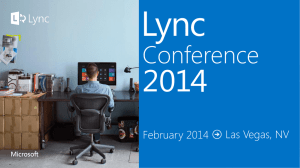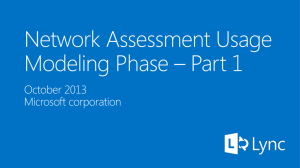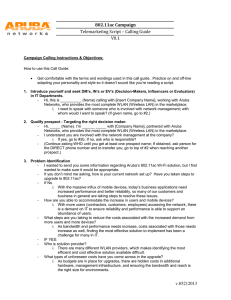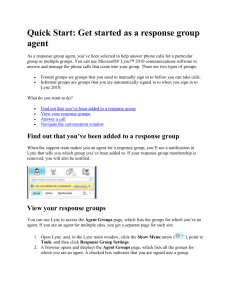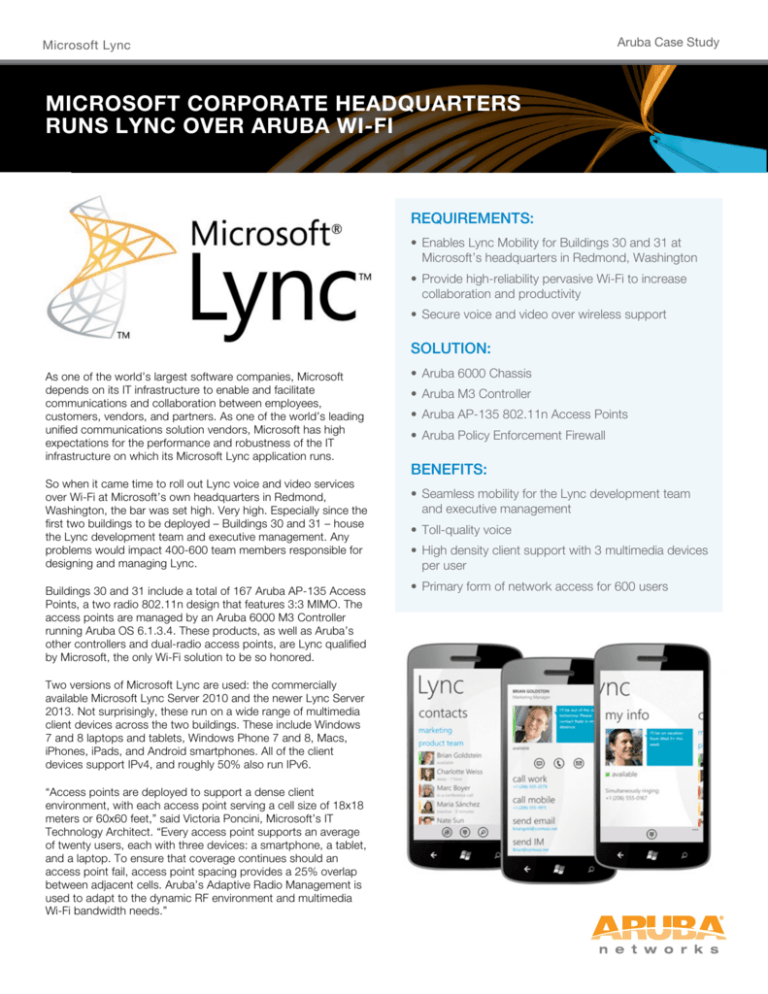
Aruba Case Study
Microsoft Lync
Microsoft Corporate Headquarters
Runs Lync Over Aruba Wi-Fi
requirements:
• Enables Lync Mobility for Buildings 30 and 31 at
Microsoft’s headquarters in Redmond, Washington
• Provide high-reliability pervasive Wi-Fi to increase
collaboration and productivity
• Secure voice and video over wireless support
solution:
As one of the world’s largest software companies, Microsoft
depends on its IT infrastructure to enable and facilitate
communications and collaboration between employees,
customers, vendors, and partners. As one of the world’s leading
unified communications solution vendors, Microsoft has high
expectations for the performance and robustness of the IT
infrastructure on which its Microsoft Lync application runs.
So when it came time to roll out Lync voice and video services
over Wi-Fi at Microsoft’s own headquarters in Redmond,
Washington, the bar was set high. Very high. Especially since the
first two buildings to be deployed – Buildings 30 and 31 – house
the Lync development team and executive management. Any
problems would impact 400-600 team members responsible for
designing and managing Lync.
Buildings 30 and 31 include a total of 167 Aruba AP-135 Access
Points, a two radio 802.11n design that features 3:3 MIMO. The
access points are managed by an Aruba 6000 M3 Controller
running Aruba OS 6.1.3.4. These products, as well as Aruba’s
other controllers and dual-radio access points, are Lync qualified
by Microsoft, the only Wi-Fi solution to be so honored.
Two versions of Microsoft Lync are used: the commercially
available Microsoft Lync Server 2010 and the newer Lync Server
2013. Not surprisingly, these run on a wide range of multimedia
client devices across the two buildings. These include Windows
7 and 8 laptops and tablets, Windows Phone 7 and 8, Macs,
iPhones, iPads, and Android smartphones. All of the client
devices support IPv4, and roughly 50% also run IPv6.
“Access points are deployed to support a dense client
environment, with each access point serving a cell size of 18x18
meters or 60x60 feet,” said Victoria Poncini, Microsoft’s IT
Technology Architect. “Every access point supports an average
of twenty users, each with three devices: a smartphone, a tablet,
and a laptop. To ensure that coverage continues should an
access point fail, access point spacing provides a 25% overlap
between adjacent cells. Aruba’s Adaptive Radio Management is
used to adapt to the dynamic RF environment and multimedia
Wi-Fi bandwidth needs.”
• Aruba 6000 Chassis
• Aruba M3 Controller
• Aruba AP-135 802.11n Access Points
• Aruba Policy Enforcement Firewall
benefits:
• Seamless mobility for the Lync development team
and executive management
• Toll-quality voice
• High density client support with 3 multimedia devices
per user
• Primary form of network access for 600 users
Aruba Case Study
Microsoft Lync
Adaptive Radio Management (ARM) automatically optimizes
performance and reliability, even in high-density environments.
ARM’s ability to minimize contention, improve airtime fairness,
and enhance the user experience is crucial as the number of
devices per employee grows.
The performance of Lync services on wireless client devices is
dependent on the capabilities of the networks over which they
operate. In particular, there are profound differences in how
wireless network vendors deliver Quality of Service (QoS) for realtime, latency sensitive applications like Lync voice and video.
organization overview
Founded in 1975, Microsoft (NASDAQ: MSFT) is the
worldwide leader in software, services and solutions that
help people and businesses realize their full potential.
Legacy networks map applications to a specific wireless
SSID and VLAN with QoS tailored to that application, e.g., a
wireless tablet would be mapped to a data VLAN. This design
is problematic when a multimedia device, like a tablet, switches
applications from data to video conferencing, or runs both at the
same time.
Aruba overcomes this issue by crafting networks that are user-,
device-, and application-aware. Deep-packet inspection identifies,
isolates, and prioritizes real-time traffic, differentiating between
multiple applications flows originating within a single device. Using
just a single SSID, QoS can be applied based on the applications
that run on each device without relying on separate VLANs.
This application-awareness extends to encrypted Microsoft
Lync traffic, where heuristics pinpoint voice and video packets
and apply the right network settings and policies. To ensure
end-to-end QoS over both wired and wireless networks – since
they’re normally used in concert – the Aruba network assigns
both wired DiffServ codepoint (DSCP) tags and Wi-Fi Multimedia
(WMM) tags.
“The effectiveness of application-awareness is readily
observable,” continued Poncini. “The system averaged 16,000
call records over a thirty day period with greater than 96% toll
quality, a fifty percent improvement over the legacy network. The
network is delivering Lync services as the designers intended,
with full fidelity and end-to-end quality of service.”
For additional information about how Aruba Wi-Fi enables
Lync mobility, please go to www.arubanetworks.com/solutions/
mobile-unified-communications or contact lyncready@
arubanetworks.com.
www.arubanetworks.com
1344 Crossman Avenue. Sunnyvale, CA 94089
1-866-55-ARUBA | Tel. +1 408.227.4500 | Fax. +1 408.227.4550 | info@arubanetworks.com
© 2012 Aruba Networks, Inc. Aruba Networks’ trademarks include AirWave®, Aruba Networks®, Aruba Wireless Networks®, the registered Aruba the Mobile Edge Company logo, Aruba Mobility
Management System®, Mobile Edge Architecture®, People Move. Networks Must Follow®, RFProtect®, and Green Island®. All rights reserved. All other trademarks are the property of their respective
owners. CS_MicrosoftLync_111512


